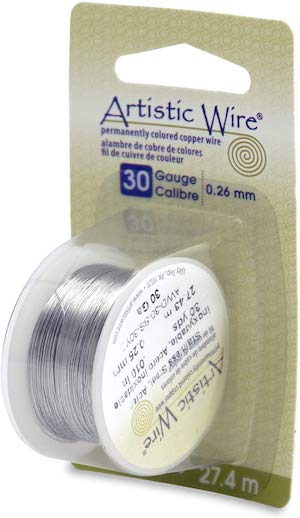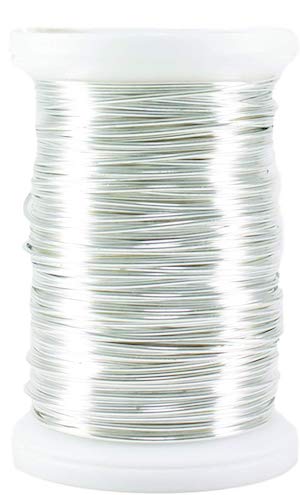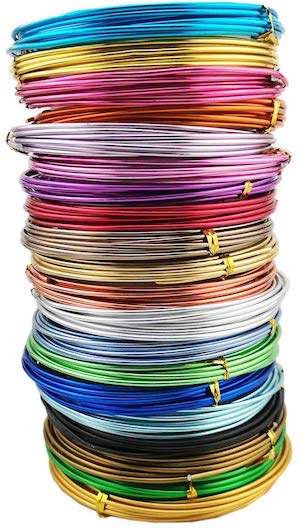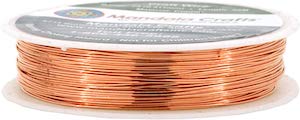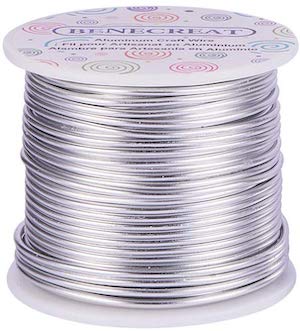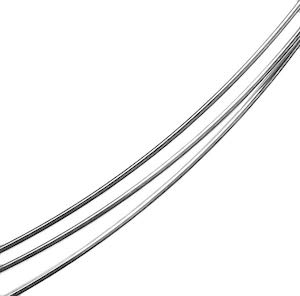There are several important things to bear in mind for jewelry making. As a result, it’s best to do your research before getting stuck in, to ensure you end up with the desired outcome.
In particular, one of the most important decisions you will have to make is what wire to use. In short, the best wire you can use for jewelry making is on the slimmer side, and between 26-30 gauge.
So read on and find out our recommendations for the best type of wire to use according to its properties, and which ones work best with different jewelry projects.
So what should you consider when looking at wires to use for your jewelry projects? Wire gauge and hardness are two of the most important factors when selecting wire for jewelry making. You also have to think about the type of metal you want to use, depending on the type of jewelry you have in mind.
Wire Gauge
The gauge of a wire refers to its thickness or diameter. The higher the number, the finer the wire is going to be. As you can imagine, the gauge of wire you should use for your jewelry is highly dependent on the type of project.
A higher gauge can be more useful for something like a frame, while a lower gauge is usually better for making more sturdy jewelry like bracelets and bangles.
So let’s get into the various gauges associated with jewelry wire and evaluate the best uses for each.
| Wire Gauge | Diameter (mm) |
|---|---|
| High Gauge (24-32) | .508mm to .203mm |
| Medium Gauge (18-22) | 1.02mm to .635mm |
| Low Gauge (12-16) | 2.05mm to 1.30mm |
High Gauge (24-32)
High gauge wire covers everything from 24 gauge upwards. High gauge wire is the thickest, and so is best suited to heavy-duty jewelry, providing security and a robust aesthetic.
Contrary to what some may think, jewelry isn’t always delicate and fine. Sometimes a chunkier look is what we should go for when making our next jewelry piece. Offering a more heavy aesthetic, high gauge wire can be a great choice for bespoke pieces and for those who prefer to go big.
Some specific examples of jewelry you can use high gauge wire for are big bracelets and bangles, thicker rings, and large clasps.
The downside to working with high gauge wire is the extra effort required to mold it into the desired shape due to it being harder to bend, as well as the heavy-duty tools that you’ll need to make it conform to your will.
Medium Gauge (18-22)
Medium gauge wire ranges from 18-22 gauge. Not too thick and not too fine, medium gauge is a well-balanced wire which you can use for a number of different jewelry projects.
Its strength lies in its versatility, and this makes it a great starting point for anyone new to jewelry-making.
At the lower end of the scale (20 gauge) you can make jump rings, pins and clasps. While with the thicker gauge (22) you can pull off stone settings easily enough.
Often available in a wide range of colors, medium gauge is definitely a great option whatever the jewelry project.
Earrings can look especially great when you use medium gauge wire, and the versatility afforded by the finer nature of it means you have much more to work with, and ultimately more freedom than with high gauge wire.
Low Gauge (12-16)
Low gauge wire is perhaps the type of wire you are most familiar with, as it is usually used for the most decorative of jewelry pieces, due to its incredibly thin nature.
While medium and high gauge wires are more suited to bigger pieces, low gauge wire is for the more delicate of jewelry. The kind that you see on display in high-end stores, the kind which feels expensive and befitting of royalty.
For this reason, use low gauge wire for jewelry that you want to use for special occasions or give as a gift for someone you love.
The best type of wire to use for wire weaving and wrapping due to its string-like diameter, low gauge is a fine choice for a fine jewelry piece.
Take this guide with a pinch of salt though, since jewelry can be made in many imaginative ways, and doesn’t always have to be limited to the right thickness.
The Hardness of the Wire
After putting some thought into and settling on the gauge of wire that you want to use for your jewelry project, the next thing to consider is the hardness.
When talking about hardness with jewelry wire, we are referring to how malleable or how easy to bend and manipulate it is.
There are 3 different recognized types of wire when it comes to hardness, and those are, full hard, half-hard, and dead soft.
It’s important to choose the right hardness when deciding on the wire since some jewelry projects require more manipulation of the wire than others. The last thing you want is to find out that you can’t bend the wire into the shape of the jewelry as it is too dense.
| Hardness | Example |
|---|---|
| Full Hard | Stainless steel |
| Half Hard | Sterling silver |
| Dead Soft | Copper |
Full Hard
Described as full-hard wire, the densest of the options available for jewelry-making is incredibly stiff, springy, and hard to manipulate.
As a result, full-hard wire isn’t ideal for most jewelry projects, as you can’t bend it into many shapes, and are usually stuck with whatever shape it comes in.
This inflexibility—both literally and in terms of its lack of uses—means that you will probably want to steer away from full-hard wire in most cases.
However, that isn’t to say there are no uses for this type of wire. Full hard wire is excellent at holding its shape and can be a great choice for clasps in particular.
Half Hard
Half hard wire is the middle-of-the-road option when it comes to wire hardness.
Not as unforgiving and hard to work with as full-hard wire, half-hard wire is relatively easy to manipulate while holding its shape better than dead soft wire.
This makes half-hard wire the best choice for the beginner jewelry maker. Having the perfect balance of malleability and rigidness, half-hard wire is the easiest to work with and the most flexible with regards to its uses.
Especially great for ear wires and hooks, half-hard wire is a solid option for a range of jewelry projects, and I personally recommend it for most jewelry you are interested in making.
Dead Soft
Dead soft wire is the easiest to manipulate, and most malleable of the 3 types of wire.
With no spring, dead-soft wire is extremely adaptable and is incredibly simple to bend and coil.
Dead-soft wire doesn’t always require the use of jewelry tools either, as you can use your hands to work it into the desired shape.
The downside to dead-soft wire is the fact that it isn’t great at holding its shape, so if you have a solid frame in mind, this might not prove to be the best choice.
As a result, a lot of jewelry you make using dead-soft wire, you will want to harden up using the process of work hardening, which we’ll cover in a moment.
Most cheap wires, such as copper and brass, fall into this category of dead soft, and so make fantastic choices for the beginner jewelry-maker.
Changing Wire Hardness
If you think that the current wire you have might be either too hard or too soft, then there is also the option of changing the hardness to suit your needs.
Work hardening describes the process of altering the state of the wire to be more soft and flexible, or stiff and springy.
If you find yourself with dead soft wire, but the jewelry you have in mind needs to hold its shape well and be sturdy, you could definitely benefit from the work hardening process.
Work hardening can be done in a variety of ways:
- For fine wires of a higher gauge, you can use flat-nosed pliers to pull the wire out and continue to do so until you notice a slight change in the hardness.
- Another method is to use a rubber mallet, or a jewelry hammer and bang the wire into shape. What this will do is strengthen the wire and make it less fragile.
Wire Shapes
As well as hardness and gauge, we can also look to the shape of the wire to help better inform our decision for our next jewelry project.
What I mean by shape, in this instance, is what you see when you take a cross-section of the wire.
The 4 main shapes for jewelry wire include round, half-round, square, and twisted.
| Shape | Key Feature |
|---|---|
| Round | Most common shape used for wire jewelry |
| Half Round | Used for banding (connecting square ends together) |
| Square | Unique aesthetic, common for banding |
| Twisted | Fancy aesthetic with either round or square wire |
Let’s take a brief look at each and when you should use them.
Round
Round wire is the one you will see in most jewelry designs. The standard for most projects, you will probably go for this one more often than the others due to its simplicity and timeless look.
Half Round
Half-round or semi-circular wire is often used to create connections with square wire. This is a process called banding, and is quite common as it gives square wire jewelry a touch more flexibility in its shape.
Square
Square wire is used to create a slightly different aesthetic for the jewelry. Sometimes it’s nice to deviate from the standard, and go for something a bit different, that’s where the square wire steps in.
As discussed previously, square wire can also be used in combination with half-round wire through the process of banding. This means that the possibilities open to you are many.
Twisted
A type of wire reserved for certain pieces, twisted wire is how you’d imagine, either square or round wire is twisted together to create a spiral-like aesthetic.
You can either try to make twisted wire yourself, or buy it directly, and use it to create something special.
The 5 Best Types Of Wire To Use
There are a great number of wires available when it comes to jewelry wire, so how do you know which are the best ones to use?
There are a few things you should look out for before you make your decision.
The first is to choose based on your experience making jewelry. If you’re just starting out, I’d recommend steering away from anything too fancy. Using karat gold is best left to the experts as fun as it may sound.
Next, consider the aesthetic you want for the jewelry piece. Are you after something glamorous that sparkles in the sun? Or something more understated that will withstand the test of time?
Last but not least, think about the purpose you need the wire for. Are you going to need to manipulate it easily and bend it at will? Or is it a fairly straightforward project that requires the wire to be more rigid and springy?
| Metal | Best Quality |
|---|---|
| Copper | Affordable and attractive |
| Aluminum | Malleable yet robust |
| Sterling Silver | Stronger than pure silver while retaining its beauty |
| Brass | Similar look to gold at a fraction of the price |
| Tiger tail | Strong and provides a unique look |
1. Copper
Let’s start out with one of the most common metals used in jewelry wire—copper.
Copper wire is so popular in the world of jewelry-making primarily due to its attractive appearance and reasonable price.
Copper wire comes in a variety of ways, meaning you can choose the specific gauge or hardness that best suits your project. On top of this, copper wire is naturally easier to manipulate and gives you ample options as to what you do with it.
The beginner’s choice, copper is for anyone starting out with jewelry-making, or anyone who is looking for an inexpensive, yet still impressive base for their jewelry.
Mandala Crafts has a great copper wire you can start off with.
2. Aluminum
Aluminum wire is a great option due to it being both strong, yet also light enough to bend into shape and use for a variety of jewelry.
Another good thing about aluminum is the many ways you can dress it up, or make it more attractive.
You can either opt for its solid silver base color, or choose a colored version, or one with an enamel coating. As such, you have some flexibility depending on the jewelry you have in mind.
Be careful when buying aluminum wire, it is often dead soft, which while a great thing for specific jewelry pieces, might not be ideal if you’re looking for something which can hold its shape well.
Check out this aluminum wire from Benecreat and see if it suits your jewelry-making needs.
3. Sterling Silver
An alloy which is made up of a high percentage of pure silver (92.5% to be exact), mixed with a small amount of copper (7.5%), sterling silver is like a slightly stronger version of pure silver.
A very popular metal alloy used in jewelry, sterling silver is a good choice with many expert jewelers, which means you can make jewelry that if you choose to use it, will really look the part.
The addition of copper adds a reasonable amount of durability to the silver, while not detracting at all from the elegant look that you typically associate with silver jewelry.
While working with pure silver could seem intimidating, not only for its cost, but also for its slightly weaker nature, sterling silver is both robust and beautiful.
The shine from sterling silver jewelry is much the same as it is for pieces made from pure silver. So for a lower price than the real thing, you can get a very similar effect.
The one thing to bear in mind with sterling silver jewelry is its susceptibility to tarnishing, especially when exposed to water.
UGems offers a great half-hard sterling silver wire which you can find in the link below.
4. Brass
Another cheap option and one ideal for starting out with—like copper—brass wire is great for most jewelry projects.
If you love the shine and color of gold jewelry, but can’t quite afford to splash out on the real stuff—I know I can’t—then brass is a solid alternative with a slightly similar aesthetic.
Brass may be slightly more difficult to bend into shape than copper, but it is still worth considering if you are starting out in the world of jewelry-making.
There is even a variety of brass wire alloys which closely mirror the color of gold, if you really have your heart set on a high-end looking piece. Alloys like ‘Jeweler’s Brass’ for instance provide that crisp, golden look that we all love.
Lastly, brass offers many different options for hardness, so you can choose the option that best suits your needs.
Check out this offering from Beadalon. A great 20 gauge brass wire for making your first piece of jewelry.
5. Tiger Tail
An interesting option for jewelry, tiger tail wire is wire which has been coated with nylon and is made of a number of strands twisted together.
Often used for bead stringing, tiger tail is highly durable and consists of several stainless steel wire threads.
Tiger tail wire is the best option for necklaces and bracelets due to its qualities and is resistant enough to not take damage from sharp gems and crystals.
Some say tiger tail wire has an ‘invisible’ look to it, in that from a distance the beads or gems can appear to be floating. So if you’re looking for a unique aesthetic for your next jewelry piece, tiger tail wire could be your best option.
Check out this Goelx Tiger Tail Wire and see if it lines up with your jewelry-making goals.
Best Wire For Different Types of Jewelry
As we’ve already explored, there are a number of factors that should influence your decision when it comes to choosing the right jewelry wire for the job.
Whether it’s hardness, gauge, or material of the wire, there are many things to keep in mind.
That’s why I’m going to try and make your life a little easier by giving you some of my favorite picks of wire for different types of jewelry, so you don’t have to spend hours deliberating.
| Type of Jewelry | Best Gauge To Use |
|---|---|
| Necklaces and Chains | Medium gauge |
| Earrings and Hoops | Medium-high gauge |
| Bracelets and Bangles | Low-medium gauge |
| Rings | Low gauge |
Necklaces and Chains
While of course a lot of your wire choice depends on personal preference when considering making a necklace a higher gauge like 26 gauge is generally a better choice.
This will give you more flexibility to manipulate it how you want, while also giving you the fine, refined look that you often see in necklaces.
The opposite can be said for chains and chokers, as you probably want them to appear thicker and stronger, so opting for a lower gauge like 16 gauge might be a better choice.
As for the material, I would lean towards sterling silver, for reasons discussed earlier. Affordable, yet classy and with that polished silver look, you can’t go too wrong with this alloy.
Earrings and Hoops
Earrings are often more delicate and so suited to a higher gauge like 24, whereas for hoops 20 gauge might be the best option, as they will keep their shape well.
The material you choose to use for earrings or hoops should not only be based on aesthetic – sterling silver and brass can look great – but also on practical factors like comfort.
If you have sensitive earrings, you are going to want to go with a material that isn’t likely to cause irritation. Hypoallergenic earrings are a great option for that reason, so if you know you might struggle with some metals, opt for karat gold or sterling silver alloy (one which doesn’t contain nickel).
Bracelets and Bangles
With bracelets, you probably want to go for wire that gives you the flexibility to bend it into different designs and shapes, so for that reason, a half-hard, middle-of-the-road gauge wire like 18 could do the job.
As for bangles, a slightly thicker wire, say 16 gauge is a good shout, as you want that sturdy quality that will endure.
With regard to material, you can choose based on your desire for jewelry. If you want a more affordable option that still looks fantastic, go for copper or brass. If you want something a bit more fancy, then aluminum or sterling silver can be great choices.
Rings
Rings can either be thick or fine, so this one is going to depend on the type of ring you’re looking to make. The material depends again on your desires, but it’s hard to deny the appeal of a sterling-silver ring.
For a thicker ring, you’ll do well with a 12 or 14 gauge wire, and some jewelry tools to harden the soft temper into the desired hardness.
As for the other end of the scale, a fine and fancy ring can be made with either 18 or 20 gauge, half-hard wire.
So, now that we’ve covered the best wire choices for whatever your jewelry project, let’s briefly go over some tips for starting out with jewelry-making.
Other Materials Needed to Make Jewelry
Making jewelry can be a really satisfying activity, and as well as enjoying the process, you can make yourself or someone you love a great new piece of jewelry from scratch.
Here are some of the most useful tools for making jewelry:
- Pliers
- Wire
- Wire cutters
- Beading thread
- Beads
- Beading needle
- Crimping tool
- Clasps
- Headpins
- Tape measure
It’s important to take into account the length of the piece of jewelry you are looking to make before you start making it too. For example, a men’s necklace should typically be around 20″, whereas a woman’s necklace can sit anywhere in the 17-30+ region.
Of course, taking exact measurements is always the best course of action.
As for how to make your jewelry stand out, you can find your, or the recipient’s, birthstone. Or, as discussed earlier, you can make it special through the use of more sought-after metals like karat gold.
Also, there are plenty of great channels on YouTube which provide fantastic tutorials that you can follow to make life easier. I especially love this video that explains everything about gauges of wire that I already touched on above, but this gives you a nice visual!

